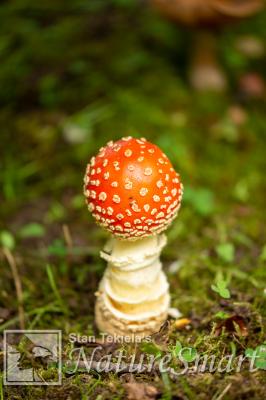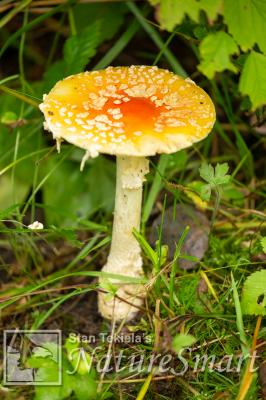View all of the titles in the
NatureSmart Bookstore


by Stan Tekiela
© NatureSmart
October 21, 2019
Moving into autumn means it’s time for mushrooms. The cooler temperatures and increased precipitation cause the shooms to pop! But, before I go any further about mushrooms, I need to give some basic cautions. First, if you ever plan on collecting wild mushrooms you should understand exactly what a mushroom is and what it does. This means understanding why it grows, how it grows and what it does. Second, there are many deadly poisonous mushrooms so you can never be too cautious. Make sure you consult a field guide or even better, two field guides because you can never be too cautious.
Recently while I was photographing Black Bears, I ran across some amazing mushrooms called the Fly Agaric or Fly Amanita (Amanita muscaria). These are large and obvious mushrooms and could be the most recognizable mushroom on the planet. No doubt you have seen these mushrooms in person or illustrated in a books or depicted in movies. It is often seen illustrated in children’s books because of its bright color. Once you have seen the picture you will no doubt recognize the mushroom. It is that common and obvious.
The Fly Agaric is a mushroom, sometimes called Toadstool, that is the genus Amanita. It got its name from the fact that it is often used to attract and kill Houseflies. The Amanitas are a group of mushrooms that contain some of the most toxic and deadly shooms on the planet. This group contains the Death Cap (Amanita phalloides) and the Destroying Angle (Amanita virosa) mushrooms, both of which will easily kill a health adult human with just one or two mouthfuls. That is not to say that you will immediately drop over dead upon eating one of these killers. No, it is a long drawn out process that actually starts about two to three days after you have ingested the deadly mushrooms and ends about a week or more later. The amatoxins in these mushrooms kill the liver so actually you die from liver failure. The only known cure for ingesting these deadly mushrooms is a liver transplant. Not pleasant!
But I don’t want to talk about the “deadly” amanitas. I want to talk about the little brother of the killers, the Fly Agaric. It can grow to over 12 inches tall and has either a bright red or vibrant orange/yellow cap. The cap is covered with dozens of white flecks that are easily wiped or washed off. Under the cap are paper thin, white, gills, which is where the spores of the mushroom are produced.
The Fly Agaric has a long white stem and a loose-fitting skirt around the upper part of the stem. All of this grows or emerges from a white ball-shaped cup at the base. Although classified as poisonous, it doesn’t contain the deadly compounds that kill your liver. It contains ibotenic acid which converts to muscimol. Muscimol is one of the principal psychoactive chemicals and causes massive hallucinations. Now before you get any crazy ideas about using this mushroom recreationally, you need to know that the amount of muscimol varies widely from region to region and season to season so you have no idea how much muscimol is in any given mushroom. In addition, the chemicals also cause intense stomach cramps, sweating, vomiting and diarrhea. Of it is reported that you are so sick that you wish you would die but you don’t.
It has also been reported that deaths from eating this mushroom, whether intentional or accidental, are rare. However, it has been estimated that 15 large caps of the Fly Agaric are enough to kill an adult. It’s best not to mess with these mushrooms.
The Fly Agaric grows around the world in northern temperate zones. Because of this, there are many reports from many different cultures around the world using the Fly Agaric for medicine or in ancient ceremonies. For example, it was recorded that the people of Siberia used this mushroom by its shamans as an alternative of achieving a trance-like statehood. It has also been used in many religious communities. The Siberia shaman would eat the mushroom and others would drink his urine. The urine, containing the psychoactive elements would be more potent than the mushroom itself and would have fewer negative side effects such as muscle twitching and sweating, suggesting that the original person eating the mushroom acted like a filter for the other compounds that causes these negative side effects.
So, this autumn when you are out running around look for the Fly Agaric. Be safe, don’t even touch it, just enjoy it with your eyes or camera. Until next time…
Stan Tekiela is an Author / Naturalist and wildlife photographer who travels the U.S. to study and capture images of wildlife. He can be followed on www.facebook.com and twitter.com. He can be contacted via his web page at www.naturesmart.com.
The nationally syndicated NatureSmart Column appears in over 25 cities spanning 7 states: Minnesota, Wisconsin, Michigan, Illinois, Ohio, New York and Pennsylvania. It is a bi-weekly column circulated to over 750,000 readers.
Wolves
Just the day before, a pack of wolves known as the Wapiti, had found a large bull bison that was weak and injured. Based on its size, this big boy was near the end of its lifespan and the winter weather was taking its toll. For a full day the wolves tried to approach the bison but when the bison...
Moose
It was one of those dark and cloudy winter days in Yellowstone National Park where the clouds are so heavy and low, you feel like you can reach up and touch the cloudy sky. A light wind helped to blow the falling snow with occasional gusts of wind causing swirls of fluffy white snow...
American Badger
It’s funny, I believe the average person knows more about the Honey Badger (Mellivora capensis), a critter of Africa and Southwest Asia than they do about the badger in our own backyard, the American Badger (Taxidea taxus). Social media has a lot to do with the Honey Badger phenomena and...
Backyard Bird Feeding
Winter bird feeding is one of the most common / popular hobbies in America. It is estimated that nearly 60 million Americans feed birds in their yards in winter or summer. That is about 40 percent of all American’s make backyard bird feeding part of their everyday activities. It’s...
View all of the titles in the
NatureSmart Bookstore
Check out Stan's latest photos at
NatureSmart Wildlife Images
Take a tour with Stan.
» More Info
Hear Stan on radio stations all across the Midwest.
» More Info

When he's out in the field, Stan relies on his Vortex Razor binoculars and Vortex Razor spotting scope to help find the subjects for his award winning wildlife photography.

For thirty years, professional wildlife photographer Stan Tekiela has counted on Hunt's Photo and Video to provide him with professional photography equipment.
From tripods to camera bodies and lenses, Hunt's has been Stan's place for everything that he needs. Personal service and prompt shipping means Stan can count on Hunt's to support his professional wildlife photography career.


Professional Wildlife Photographer Stan Tekiela always uses Feeder Fresh in his seed feeders to help keep the feeders and food dry, clean and mold free.
He also uses Feeder Fresh Nectar Defender in all of his hummingbird feeders. It safely keeps nectar fresh longer.